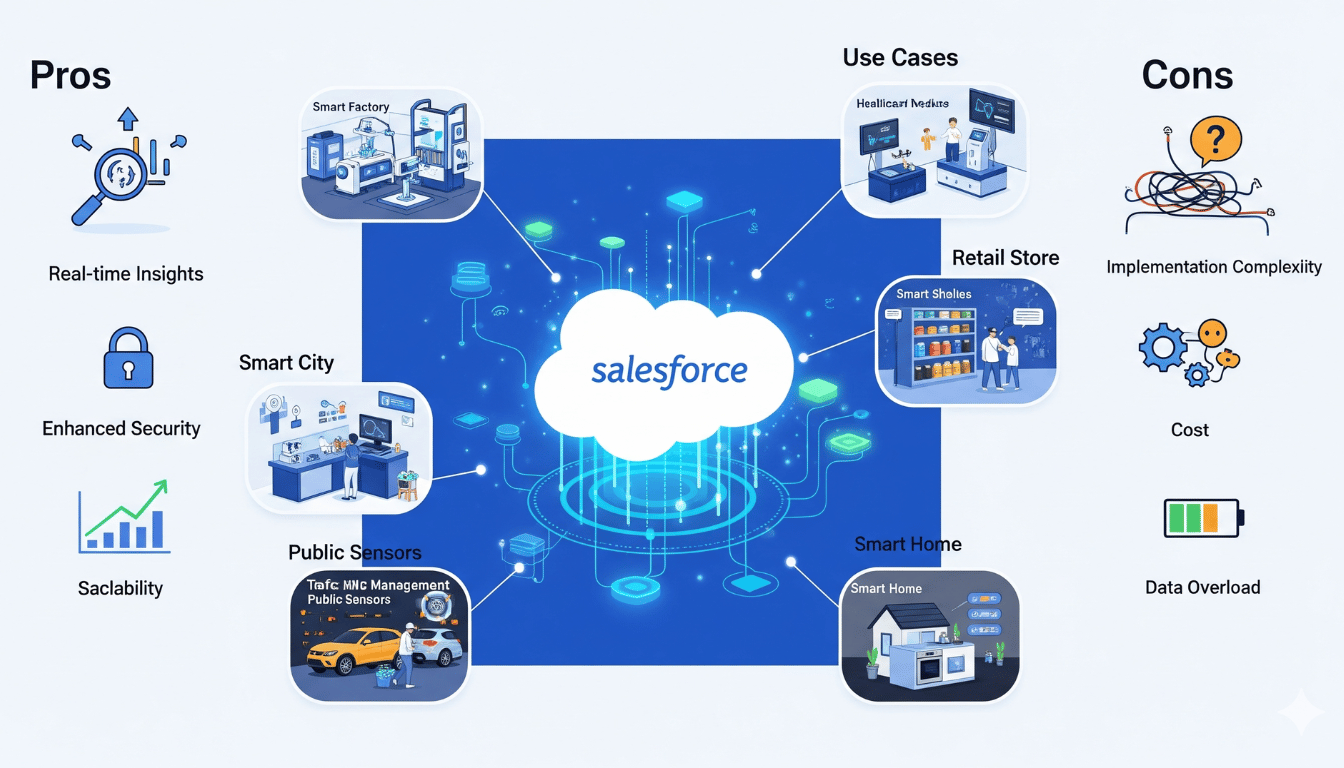As businesses become more data-driven and customer-focused, the Internet of Things (IoT) continues to reshape operations. Enterprises today are flooded with real-time data from connected devices, but collecting data alone isn’t enough. The true value lies in integrating device data with customer context to drive intelligent actions. That’s where Salesforce IoT Cloud comes in.
Launched as part of the Salesforce ecosystem, IoT Cloud connects data from devices, applications, and sensors to Salesforce’s CRM platform. By doing so, it helps businesses turn massive streams of IoT data into meaningful, real-time customer interactions. But while its potential is powerful, Salesforce IoT Cloud also has its constraints.
Let’s dive into the key benefits and limitations of this platform to understand its fit in your digital transformation strategy.
What is Salesforce IoT Cloud?
Salesforce IoT Cloud is a platform that collects, processes, and analyzes IoT data in real time and uses it to enhance customer experiences via the Salesforce ecosystem (Sales Cloud, Service Cloud, Marketing Cloud, etc.). It uses Thunder, Salesforce’s scalable event-processing engine, to manage billions of daily events from connected devices.
Key Benefits of Salesforce IoT Cloud
1. Customer-Centric IoT
Unlike traditional IoT platforms that focus only on devices, Salesforce IoT Cloud integrates customer profiles, behaviors, and history into event processing. This allows for context-aware automation and personalized engagement.
2. Real-Time Insights and Actions
With Thunder, Salesforce can ingest and analyze massive volumes of streaming data in real-time. Businesses can create rules and logic (known as “orchestration”) to trigger actions automatically, such as sending alerts or creating support cases.
3. Low-Code Orchestration
Salesforce IoT Cloud offers a visual interface to define business logic and workflows, making it accessible to non-technical users. This allows marketers, service agents, or sales managers to build automation without heavy IT dependency.
4. Seamless CRM Integration
IoT Cloud data flows directly into the Salesforce CRM, enabling teams to view device status, usage, and events within customer records. This improves service responsiveness and supports proactive support strategies.
5. Scalability and Reliability
As part of the Salesforce ecosystem, IoT Cloud benefits from enterprise-grade security, uptime, and scalability, suitable for global deployments.
Limitations of Salesforce IoT Cloud
1. Complex Pricing Model
Salesforce pricing can be complex and expensive, especially for businesses looking to process large volumes of device data. Licensing and consumption-based models may increase costs over time.
2. Limited Edge Computing Support
Salesforce IoT Cloud is primarily a cloud-based solution. Edge processing capabilities are minimal, which could be a drawback for applications needing ultra-low latency or offline processing.
3. Integration Challenges
While integration with Salesforce CRM is seamless, connecting third-party IoT platforms, legacy systems, or non-standard devices may require custom middleware or additional services.
4. Dependence on Salesforce Ecosystem
To get full value, businesses must already use or be willing to adopt other Salesforce products. Standalone use of IoT Cloud without CRM integration limits its potential.
5. Learning Curve for Customization
Although low-code tools exist, complex orchestration rules, custom analytics, or integrations may still require development expertise in Apex or use of Salesforce APIs.
Ideal Use Cases
- Predictive Maintenance: Triggering service calls before equipment fails.
- Connected Devices: Monitoring smart home, automotive, or wearable tech usage.
- Usage-Based Billing: Automating invoicing based on real-time device usage data.
- Proactive Customer Service: Notifying users or agents when anomalies occur.
- Field Service Optimization: Dispatching technicians based on live device alerts.
Final Thoughts
Salesforce IoT Cloud offers a powerful advantage by combining IoT data with customer context. It empowers businesses to shift from reactive to proactive engagement, improve service delivery, and personalize interactions in real time.
However, its value depends on your existing Salesforce adoption, integration needs, and budget. For organizations deeply invested in the Salesforce ecosystem, IoT Cloud can be a game-changer. For others, careful consideration of costs, architecture, and scalability is essential.
